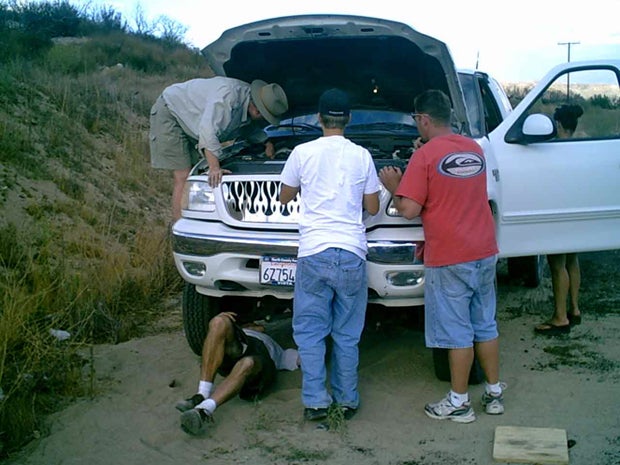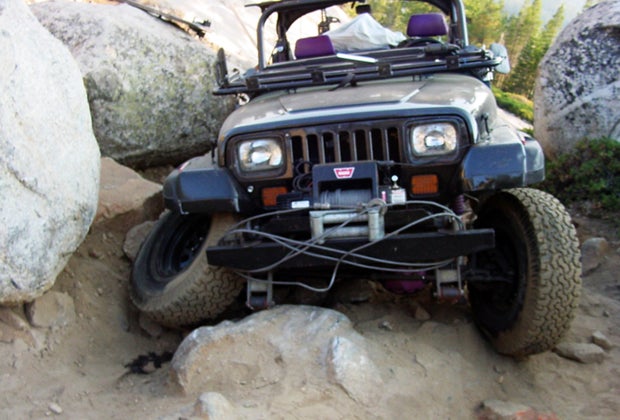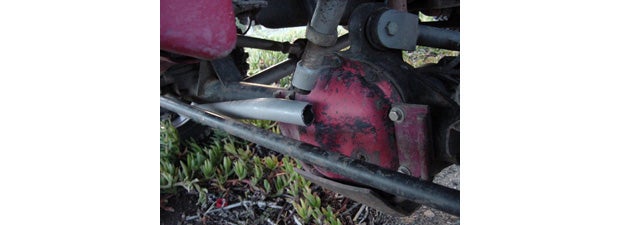
Normally we think of bringing along basic supplies for trail rides, but this time we’re focusing on spare parts. Bear in mind that the farther you are from civilization, the more troublesome a breakdown can be.
Remember this important axiom of four-wheeling: The more difficult and more remote the trip, the more stuff you need to take.
For a day trip to the local mountains, you may only need to throw in a cooler and a warm jacket. Your buddy can run into town and bring back tools and parts. For a longer camping trip or a difficult trip like the Rubicon, you need a lot of gear, and in particular spare parts.
You may wonder, what are "trail prices"? The term refers to the extra price you pay to compensate for a critical part you didn't bring along. One example is the part you had to buy from a buddy. You might pay three times what it cost at the auto parts store. Another example is the time needed to acquire or fabricate a part. In essence, it’s any cost that allows you to drive off the trail under your own power.
Here are the top three areas to focus on:
-Tires
-Drive train
-Electronics
Tires top the list because of all the abuse and stress they take. Of course, your vehicle comes with a spare tire. Is it in good shape and inflated to proper level? Do you have a tire repair kit? Many tire problems experienced off the highway can be repaired on the spot, so it’s good to review tire repair procedures.

The drive train also takes a lot of abuse. Tie rods and drag links are particularly susceptible. They hang down in front of the vehicle and are susceptible to being hit and bent, even broken. Consider buying heavy-duty replacement parts. They are pricey and available only from a dealer, but you’re stuck without functioning parts. Axles, u-joints and drive shafts are at risk as well. A set of U-joints are small, easy to pack and good insurance. A complete set of front axles (inner and outer for both left and right) is a good investment if you are doing extreme and remote trails like the Rubicon.
The electronic system in today's vehicle has components and sensors for which there is no work around. The worry here is that a critical part will go out leaving you stranded. Without a spare sensor the vehicle's brain will not function. On the list of critical parts with no work around are your coil/coil pack, fuel pump, MAP sensor, crank sensor and the starter (on automatic transmissions). Spark plugs and spark plug wires (on older vehicles) bear watching, too. Replace the set of wires if any are cracked. When you replace the wires, save the longer ones and pack them with your spare gear. If you ever need a spark plug wire while off road, you’ll have a spare.
Regular inspection, while important, won’t catch all the parts that are ready to go. Sensors are perfect examples. There’s no way to tell in advance when a sensor will fail. If your vehicle has a lot of miles on it, I encourage you to replace the sensors mentioned above, and keep the old one to bring as a spare.
Upgrade vs. Stock
One big decision 4WD owners need to make after buying a vehicle is whether (and to what extent) to upgrade their vehicle. Should they swap in a heavy-duty tie rod with beefier tie rod ends, for example, or leave the vehicle in stock condition? Understand that upgrading adds cost and, in the case of heavy-duty tie rods, new tie rod ends might be available for purchase only from the manufacturer. Damage one on the Rubicon and you will be waiting on the Greyhound bus to deliver a part (and that is just into the closest town, not out on the trail).
There are good reasons to go either way. My suggestion is that if you decide to upgrade your rig, keep the stock parts in your vehicle. You may discover while on the trail it is easier to convert back to stock parts than to repair.
Final Route: Fabricate, Fix
Even with a comprehensive set of spare parts, you may find that you need to fabricate or fix a certain part. Consequently, I suggest you buy and pack some additional general-purpose gear. Useful spares include fuses, hoses, sealants, hose clamps, baling wire, electric wire, chain, duct tape, zip ties, ratchet straps, and the ability to weld. Install a Premier Welder under the hood. Now you’ve got a welder at your disposal, but it doesn’t take up valuable space inside your vehicle.

Broken Track Bar
Many four wheelers have fixed a bent tie rod using the handle from a Hi-lift to reinforce the tie rod. A few track bars were fixed (just to get home) by welding two big wrenches across the broken section. A cracked axle tube was held together with chain wrapped around the lower control arms and then using the winch to take the slack out of the chain. A broken rear control arm bracket was held together with a number of ratchet straps until pavement was reached.
A mechanic’s tool set is always valuable. You don’t need a full, 200-piece set, however. Select the top tools, and store in soft-sided containers (pouches or military packs). Those will tuck nicely into nearly any spare space or crevice.
Final Thoughts
Taking a friend on the trail with a similar vehicle doubles your spare parts. While it will not help get you off the trail, AAA's 200-mile tow plan will get your vehicle home where it is easier to work on it. And in the worst case turn the hubs to free-wheeling and drop the rear drive shaft. Yep, turn your vehicle into a trailer.
Packing spare parts may seem like a daunting task. There’s no way to know in advance which, if any parts, will crap out on you. And, you have a limited amount of space to work with.
Driving off-road for decades has given me some invaluable insight; following the suggestions above will help ensure any breakdown you experience has a minimal effect on your trip.
MORE TRAIL TIPS STORIES
10 Habits of Highly Admirable 4-Wheelers
Trail Tips: A Fire Extinguisher is Crucial Off-Road Gear
How to Replace U-Joints on Your 4x4
Badlands Off-Road Adventure
Off-road trainer Tom Severin shares insight and tips on a variety of topics related to preparing you for that next off-road adventure. With over 40 years of off-road experience, Severin operates under his business Badlands Off-Road Adventures. He is a certified professional 4WD Trainer by the International 4-Wheel Drive Trainers Association and a Wilderness First Responder (WFR). He is a member of the California Association of Four Wheel Drive Clubs (CA4WDC), United Four Wheel Drive Associations and the BlueRibbon Coalition. He also is a certified UFWDA and a CA4WDC 4WD instructor.
For more information about Badlands Off-Road Adventures, 4x4training.com.


 Your Privacy Choices
Your Privacy Choices